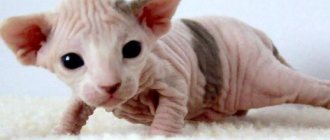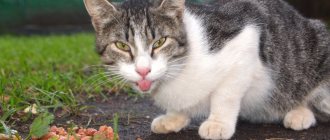Causes and provoking factors
Bronchial asthma in cats is an inflammatory process of the respiratory tract, in which muscle spasm occurs, narrowing of the bronchial lumens to such an extent that breathing becomes difficult. This situation sometimes threatens the pet’s life.
Asthma is common in cats
The main factors causing the manifestation of this process are similar to human ones.
Respiratory infections
Although cats are more resilient to changing weather conditions than humans, they can also develop various infections, both viral and bacterial. A cough can indicate a cold, bronchitis, or even pneumonia. These phenomena are often accompanied by additional symptoms such as sneezing, nasal discharge, decreased appetite and apathy.
Important! Lack of timely treatment can lead to serious consequences and even a threat to the cat’s life.
Actually asthma
It can occur at any age, but some breeds have an increased predisposition to it, including Persian and Burmese cats. The disease is similar to an allergy.
Unfortunately, asthma is incurable. Treatment is used to reduce symptoms and improve the quality of life of the affected animal. Regular consultation with a veterinarian and examinations are required.
Leukemia
A chronic disease caused by a virus. Many infected cats remain symptom-free for a number of years. However, when the disease makes itself known, one of the symptoms is simply a cough, which is often accompanied by general weakness, weight loss or diarrhea.
Asthma is often a hereditary disease.
Causes of feline asthma
The triggers of asthma in cats are poorly understood, however, it is known for sure that the main cause of the disease is the body’s allergic predisposition.
Among the main factors are the following:
- sensitivity to allergies of some cat breeds;
- genetic predisposition;
- stressful situations;
- infectious viral pathological processes;
- non-infectious diseases of the respiratory system;
- contact with allergenic substances - pollen, household chemicals, skin parasites, cigarette smoke, house dust.
An older cat and a small kitten have an equal chance of developing asthma. The phenomenon may be seasonal, when exposure to allergens occurs at different times of the year under favorable conditions.
Stages and warning symptoms
Asthma in cats and its symptoms are a fairly common allergic airway syndrome.
Epilepsy in cats: symptoms, treatment, how to stop seizures
The main symptoms include pulmonary constriction and increased mucus production, leading to inflammatory changes. The cat begins to cough frequently. Just like in humans, a cat's cough comes in many forms: it can be wet, dry, wheezing, or vomiting. This is a reflex reaction to irritation of the nerve endings in the mucous membrane of the upper respiratory tract.
Important! Cough accompanies various, more or less serious diseases, so it cannot be ignored and your pet must be shown to a doctor.
The main symptoms of asthma in a cat:
- restless behavior, rushing from corner to corner;
- characteristic posture during an attack: bent paws, lowered head, heavy breathing with an open mouth;
- sudden attack of suffocation;
- hacking cough;
- wheezing with whistling;
- fatigue after an attack, lethargy.
The main stages of feline asthma are shown in the table.
| Stage | Characteristic |
| Soft | · rare attacks; Duration of attack is less than 1 minute; · the animal quickly recovers after an attack. |
| Middle | · attacks are rare; The attack is accompanied by severe symptoms. |
| Heavy | · attacks are life-threatening; The cat may suffocate and die. |
The owner’s task is to prevent the disease from progressing from an early stage to a more severe form.
Symptoms of asthma in cats:
An acute attack begins with sudden difficulty breathing and is accompanied by coughing and wheezing. This is due to a sharp contraction of the smooth muscles surrounding the bronchi.
- coughing attacks (characteristic posture - the cat sits on bent legs, the neck is extended and inclined to the floor). Sometimes an asthma attack can be mistaken for trying to regurgitate a hairball.
- difficulty breathing, wheezing, shortness of breath
- As the condition worsens, lethargy, drowsiness, apathy, and loss of appetite appear
- in severe cases, the cat lies on its stomach, its mouth is open, and breathing is heavy. Due to oxygen deficiency (cyanosis), the mucous membranes have a bluish color
Diagnostics in a veterinary clinic
Diabetes mellitus in cats: symptoms and treatment
To diagnose a disease in a cat, it is necessary to describe in detail to the veterinarian all the signs and characteristic features of the attack. Next, the doctor prescribes tests:
- blood test to identify allergens, examination of general health;
- Chest x-ray: allows you to identify thickening of the walls of the bronchi, diaphragmatic stretching, identify formations in the lungs, and exclude bronchitis;
- test for diseases of viral and infectious origin.
Further diagnostics include:
- examination of the animal;
- using a stethoscope to listen to the lungs;
- Carrying out individual tests: it all depends on the condition of the animal.
When diagnosing, the following diseases are excluded:
- mycoplasmosis;
- lung helminths;
- neoplasms;
- bordetellosis;
- viral rhinotracheitis;
- pneumonia;
- cardiac pathologies.
Diagnosis of asthma in cats is carried out by x-ray examination
Diagnosis and treatment of asthma in cats
Asthma in cats is similar in symptoms to a number of other diseases.
, and the veterinarian needs to differentiate it from infectious bronchitis, dirofilariasis (helminthic disease), heart and pulmonary failure, pulmonary embolism, pleurisy, tumors and foreign bodies in the respiratory organs, and pneumonia.
The most informative are
general clinical blood test and chest x-ray. An x-ray shows thickening of the walls of the bronchi and stretching of the diaphragm. Using X-rays, other pathologies of the lungs and heart are also detected: pneumonia, pulmonary edema, heart problems, the presence of a foreign body in the lumen of the respiratory tract.
A complete blood count usually shows high levels of eosinophils, protective blood cells that fight foreign proteins in the body. Eosinophilia is most often observed in allergic diseases, but also in helminthic infestations. Therefore, it is recommended to take a stool test for worm eggs and cysts.
Treatment and relief of asthma attacks
Symptoms and treatment of asthma in cats depend on the type and severity of the disease.
Piroplasmosis in cats: symptoms and treatment
Treatment involves the medicinal option of using tablets and drugs. Surgical intervention is not applicable in this case.
Basics of treating asthma in cats:
- the treatment regimen and prescribed medications depend on the stage of the disease and symptoms;
- treatment is complex;
- The basis of therapy is dilating drugs in the form of an aerosol and are intended to stop an attack;
- it is possible to use hormonal drugs to treat inflammatory processes in the respiratory tract;
- sometimes antibiotic drugs are prescribed;
- It is important to use vitamin complexes to maintain immunity.
Possible options for hormonal drugs intended to treat a sick animal:
- pills;
- injections;
- aerosol.
Important! It is possible to use all three types of medications at the same time on the recommendation of a doctor. It all depends on the stage and severity of the disease.
The table below shows the advantages and disadvantages of using different forms of treatment:
| Form | Advantages | Flaws |
| Pills | Easier to use at home. The therapeutic effect is long-lasting. | The therapeutic effect takes only an hour. |
| Injections | They quickly enter the body and act instantly. You can install it right away. | Difficult to use at home. |
| Aerosols | Convenient to use. Local action, that is, it does not affect other organs. | Slow cumulative effect. The effect appears after two to three weeks. |
Treatment of asthma in cats should be carried out in a clinical setting
Anti-inflammatory therapy
The purpose of this therapy is to relieve inflammation and reduce swelling of the bronchi.
Different forms of glucocorticoids are used:
- inhalation options: fluticasone propionate;
- injection drugs: dexamethasone, prednisolone;
- tablets: prednisolone, methylprednisolone;
- bronchodilators to relax the bronchial system and reduce spasms. The drugs come in inhaler form. Used in combination with steroids: albuterol.
What to do at home
Basic rules of first aid for animals:
- the best popular advice is to recommend that the owner himself calm down;
- make sure that the cat does not hurt itself;
- eliminate possible dangers for her in space;
- during an attack, you should not grab the animal;
- after the seizures stop, move the animal to a box, a safe place, or take it to a doctor;
- Monitor the symptoms of attacks so that you can later tell them to the veterinarian for an accurate diagnosis.
In case of a prolonged and severe attack, you should:
- actions must be quick and decisive;
- urgently take the animal to the veterinarian;
- if it is not possible to get to the clinic in the near future, you should consult a doctor by phone during the attack;
- You can call a specialist to your home, if possible;
- use the required drug if it has already been prescribed and purchased in advance.
To treat asthma at home, it is better to consult a doctor
Danger to humans
It is believed that cats are additional irritants for asthmatics. The opposite situation is also possible in the house: when the asthmatic is the cat itself.
Bronchial asthma has no direct danger to humans. This disease is not transmitted as an infection. The negative impact on humans of asthma in a cat manifests itself as follows:
- it is difficult for the pet owner to observe seizures, especially if they are severe and convulsive;
- the owner’s serious experiences can have a negative impact on the psyche, especially when it comes to a child.
Important! For adults, sedatives may be used. It is necessary to conduct a preventative conversation for the child to calm him down.
Prevention measures
The basis for preventing asthma in cats is vaccination against viral and infectious diseases. To prevent pathology, you need to carefully monitor the cleanliness of the room where your pet lives. Since in winter, not only in people, but also in cats, the protective function of the immune system decreases, during this period it is necessary to take vitamin complexes. It is equally important to regularly ventilate the apartment/house so that the mucous membrane of the respiratory tract does not dry out. If your pet has a tendency to have an allergic reaction, then it is worth removing irritating plants and other possible allergens from the room. It is also recommended to refrain from smoking at home, since tobacco smoke often causes asthma in cats.
Preventing asthma
Basic preventive rules in order not to provoke attacks:
- maintaining hygiene in the apartment where the pet lives;
- daily wet cleaning of the premises;
- using an air purifier;
- In summer, during the growing season of plants, open windows less frequently to prevent allergens from entering the air;
- proper pet nutrition, balance, hypoallergenicity. Do not use products that cause food allergies: lactic acid, chicken, lamb, corn;
- hygiene and care for the pet itself, the use of hypoallergenic cosmetics, treatment for parasites.
Thus, there is no 100% effective treatment for feline asthma. The manifestation of the attacks themselves can be significantly alleviated or stopped with the use of special medications. In any case, you cannot do without consulting a veterinarian. The approach to treatment should always be individual. The use of preventive measures helps reduce the number of attacks or significantly ease their course.
What is asthma
Inflammation of the lungs, which is caused by inhaled allergens, leads to symptoms of asthma in cats . This inflammation occurs when an animal inhales an allergen. The body recognizes it as an aggressive agent and activates the immune system, triggering an allergic reaction. This mechanism narrows the airways and leads to the accumulation of mucus in them. Asthma symptoms can range from a mild cough or wheezing to a full-blown attack similar to that of a human.
Although feline asthma has no effective treatment as such, its symptoms can be controlled. With the help of certain preventive measures and the use of special medications, its development can be prevented. To best solve the problem, you need to contact a veterinarian who will prescribe an individual treatment plan, according to the examination and test data obtained.
Description of asthma
Just like in humans, asthma in cats results in narrowing of the bronchial passages, which causes coughing attacks, shortness of breath and wheezing. Sometimes, during a mild attack of feline asthma, the symptoms can be confused with occasional hairball regurgitation. Also, the owner of the animal may think that he has choked on a piece of food.
Typically, a cat can recover quickly from this type of attack and symptoms for a period of time. This gives the breeder an additional reason to forget about the episode without suspecting anything. However, serious consequences can also occur that are potentially life-threatening for the pet. Be sure to take him to the vet as soon as you notice any suspicious symptoms.
Important! The reason for the examination may be any signs of breathing problems.
Feline asthma is a breathing condition in which the airways in the lungs become narrowed and inflamed. This disease can develop in any breed and gender. The exact cause of asthma remains unknown, but allergens are overwhelmingly involved.
During allergic asthma, mucus forms in the animal's airways, which causes the walls of the airways to swell, narrowing the air passage. This condition gives rise to spasms. They can manifest themselves in wheezing and difficulty breathing, coughing. Without treatment, as with human asthma, suffocation and death can occur.
Causes of the disease
The exact culprit for this reaction in the cat’s body has not been identified. However, the most common cause is contact with allergens. Asthma in cats can be triggered by a variety of allergens, including various aerosols, cleaning products, detergents and cosmetics. Also common culprits for allergies are dust, mold, smoke or pollen. Perfumes and other allergenic substances that can be inhaled can trigger a widespread reaction.
Also, an asthma attack in cats can be caused by environmental elements such as cold, humidity, and heat. Risk factors include stress and physical overload. A respiratory condition aggravated by a bacterial or viral infection can greatly complicate the symptoms.
Stages of disease development
The severity of the symptoms of the disease is divided into 4 categories: mild, moderate, severe and life-threatening. In the first stage, the disease rarely appears and does not cause discomfort to the animal. The second stage is characterized by more frequent manifestations with complicated symptoms. In the third stage of the disease, the symptoms interfere with the animal’s full life, causing suffering. The fourth stage is the most dangerous. When it occurs, the airways are narrowed to the maximum level, as a result of oxygen starvation, the cat’s nose turns blue, the condition is critical.
Return to content











